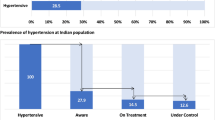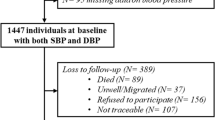Abstract
Hypertension has been rapidly growing in Bangladesh. However, there has been limited analysis of differences in the hypertension cascade across socio-demographic groups. This study was a secondary analysis of the 2017–18 Bangladesh Demographic and Health Survey. Four dichotomous outcome variables – hypertension prevalence, awareness among those with hypertension, treatment among those aware, and control among those treated – were analyzed. The variation of each outcome was assessed across socio-demographic factors. The association between socio-demographic characteristics and outcomes was analyzed using logistic regression. Less than half of the hypertensive individuals were aware of their hypertension (42.5%), and awareness was higher among those who were older, female, of higher household wealth, and living in urban areas. Among those aware, most were receiving treatment (87.4%), and this proportion was higher in older individuals (89.2% among 65 + , 70.4% among 18–24; p < 0.001). One-third of those treated (33.8%) had their blood pressure controlled, and this was higher among younger and more educated individuals. In multivariable models stratified by rural/urban community, most of the aforementioned trends remained with additional differences between communities. Notably, the association of higher education level with treatment odds differed in rural and urban communities (OR 0.34 [95%CI 0.16, 0.75] in rural; OR 2.83 [95%CI 1.04, 7.73] in urban). Efforts to improve hypertension awareness among individuals who are younger, male, of lower household wealth, and in rural areas are required to address disparities in care. Socio-demographic variations in hypertension awareness, treatment, and control must be considered to design targeted interventions for each step of the cascade.
This is a preview of subscription content, access via your institution
Access options
Subscribe to this journal
Receive 12 digital issues and online access to articles
$119.00 per year
only $9.92 per issue
Buy this article
- Purchase on Springer Link
- Instant access to full article PDF
Prices may be subject to local taxes which are calculated during checkout

Similar content being viewed by others
Data availability
All questionnaire data for the 2017–18 BDHS was requested from the DHS Program, which provides this data to individuals for academic purposes upon request and registration. The dataset can be found at https://dhsprogram.com/methodology/survey/survey-display-536.cfm.
References
Abbafati C, Machado DB, Cislaghi B, Salman OM, Karanikolos M, McKee M, et al. Global burden of 87 risk factors in 204 countries and territories, 1990–2019: A systematic analysis for the Global Burden of Disease Study 2019. Lancet. 2020;396:1223–49.
Olsen MH, Angell SY, Asma S, Boutouyrie P, Burger D, Chirinos JA, et al. A call to action and a lifecourse strategy to address the global burden of raised blood pressure on current and future generations: the Lancet Commission on hypertension. The Lancet: Lancet Publishing Group; 2016. p. 2665–712.
Danaei G, Singh GM, Paciorek CJ, Lin JK, Cowan MJ, Finucane MM, et al. The global cardiovascular risk transition: Associations of four metabolic risk factors with national income, urbanization, and western diet in 1980 and 2008. Circulation. 2013;127:1493–502.
Mills KT, Bundy JD, Kelly TN, Reed JE, Kearney PM, Reynolds K, et al. Global disparities of hypertension prevalence and control. Circulation 2016;134:441–50.
Global Burden of Disease Collaborative Network. Global Burden of Disease Study 2019 (GBD 2019) Results. Seattle, United States; 2020.
Joshi P, Islam S, Pais P, Reddy S, Dorairaj P, Kazmi K, et al. Risk factors for early myocardial infarction in South Asians compared with individuals in other countries. J Am Med Assoc. 2007;297:286–94.
Akl C, Akik C, Ghattas H, Obermeyer CM. The cascade of care in managing hypertension in the Arab world: A systematic assessment of the evidence on awareness, treatment and control. BMC Public Health. 2020;20:835.
Chow CK, Teo KK, Rangarajan S, Islam S, Gupta R, Avezum A, et al. Prevalence, awareness, treatment, and control of hypertension in rural and urban communities in high-, middle-, and low-income countries. JAMA - J Am Med Assoc. 2013;310:959–68.
Wozniak G, Khan T, Gillespie C, Sifuentes L, Hasan O, Ritchey M, et al. Hypertension Control Cascade: A Framework to Improve Hypertension Awareness, Treatment, and Control. J Clin Hypertens. 2016;18:232–9.
Staessen JA, Wang JG, Thijs L. Cardiovascular protection and blood pressure reduction: A meta-analysis. Lancet 2001;358:1305–15.
Turnbull F, Neal B, Algert C, Chalmers J, Woodward M, MacMahon S, et al. Effects of different blood-pressure-lowering regimens on major cardiovascular events: Results of prospectively-designed overviews of randomised trials. Lancet 2003;362:1527–35.
Alam D, Robinson H, Kanungo A, Hossain MD, Hassan M. Health system preparedness for responding to the growing burden of non-communicable disease – a case study of Bangladesh. Melbourne: Nossal Institute for Global Health; 2013 February 2013. Report No.: 25.
Legido-Quigley H, Naheed A, Asita De Silva H, Jehan I, Haldane V, Cobb B, et al. Patients’ experiences on accessing health care services for management of hypertension in rural Bangladesh, Pakistan and Sri Lanka: A qualitative study. PLoS ONE. 2019;14:e0211100.
Rawal LB, Kanda K, Biswas T, Tanim MI, Poudel P, Renzaho AMN, et al. Non-communicable disease (NCD) corners in public sector health facilities in Bangladesh: A qualitative study assessing challenges and opportunities for improving NCD services at the primary healthcare level. BMJ Open. 2019;9:e029562.
Bangladesh Ministry of Health & Family Welfare. Non-Communicable Disease Control Operational Plan, January 2017-June 2022. Directorate General of Health Services; 2017.
National Institute of Population Research Training, ICF. Bangladesh Demographic and Health Survey 2017-18. Dhaka, Bangladesh and Rockville, Maryland, USA; 2020.
Verdecchia P, Angeli F, Poeta F, Reboldi GP, Borgioni C, Pittavini L, et al. Validation of the A&D UA-774 (UA-767Plus) device for self-measurement of blood pressure. Blood Press Monit. 2004;9:225–9.
Unger T, Borghi C, Charchar F, Khan NA, Poulter NR, Prabhakaran D, et al. 2020 International society of hypertension global hypertension practice Guidelines. Hypertension. 2020;75:1334–57.
Mishra SR, Ghimire S, Shrestha N, Shrestha A, Virani SS. Socio-economic inequalities in hypertension burden and cascade of services: Nationwide cross-sectional study in Nepal. J Hum Hypertens. 2019;33:613–25.
Jafar TH, Gandhi M, Jehan I, Naheed A, de Silva HA, Shahab H, et al. Determinants of uncontrolled hypertension in rural communities in South Asia-Bangladesh, Pakistan, and Sri Lanka. Am J Hypertens. 2018;31:1205–14.
Iqbal A, Ahsan KZ, Jamil K, Haider MM, Khan SH, Chakraborty N, et al. Demographic, socioeconomic, and biological correlates of hypertension in an adult population: evidence from the Bangladesh demographic and health survey 2017–18. BMC Public Health. 2021;21:1229.
Hossain A, Suhel SA, Chowdhury SR, Islam S, Akther N, Dhor NR, et al. Hypertension and undiagnosed hypertension among Bangladeshi adults: Identifying prevalence and associated factors using a nationwide survey. Front Public Health. 2022;10:1066449.
Gupta R, Kaur M, Islam S, Mohan V, Mony P, Kumar R, et al. Association of household wealth index, educational status, and social capital with hypertension awareness, treatment, and control in South Asia. Am J Hypertens. 2017;30:373–81.
Alam DS, Chowdhury MA, Siddiquee AT, Ahmed S, Niessen LW. Awareness and control of hypertension in Bangladesh: Follow-up of a hypertensive cohort. BMJ Open. 2014;4:e004983.
World Bank. Hypertension and Type-2 Diabetes in Bangladesh: Continuum of Care Assessment and Opportunities for Action. Washington, DC; 2019.
Author information
Authors and Affiliations
Contributions
Conception or design of the work: MAB, YC, DCB. Data collection: not applicable. Data analysis and interpretation: MAB, YC, DCB. Drafting the article: MAB. Critical revision of the article: MAB, NC, MDI, AN, DCB. Final approval of the version to be submitted: MAB, YC, NC, MDI, AN, DCB.
Corresponding author
Ethics declarations
Competing interests
The authors declare no competing interests.
Ethical approval
Ethical approval for this type of study was not required by the University of California, San Francisco since the data are de-identified and any geo-spatial data are displaced to protect the confidentiality of survey respondents.
Additional information
Publisher’s note Springer Nature remains neutral with regard to jurisdictional claims in published maps and institutional affiliations.
Rights and permissions
Springer Nature or its licensor (e.g. a society or other partner) holds exclusive rights to this article under a publishing agreement with the author(s) or other rightsholder(s); author self-archiving of the accepted manuscript version of this article is solely governed by the terms of such publishing agreement and applicable law.
About this article
Cite this article
Babagoli, M.A., Chen, YH., Chakma, N. et al. Association of socio-demographic characteristics with hypertension awareness, treatment, and control in Bangladesh. J Hum Hypertens 37, 993–999 (2023). https://doi.org/10.1038/s41371-023-00815-z
Received:
Revised:
Accepted:
Published:
Issue Date:
DOI: https://doi.org/10.1038/s41371-023-00815-z



